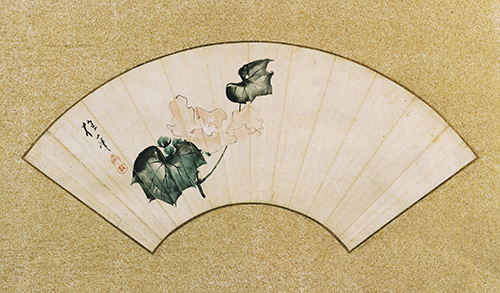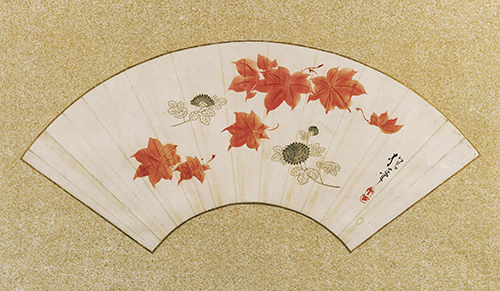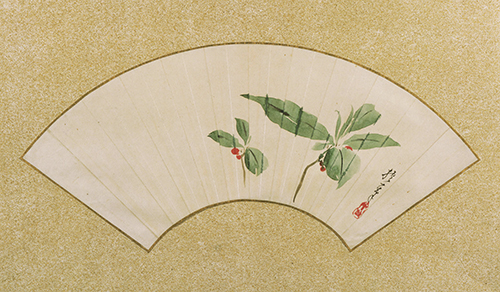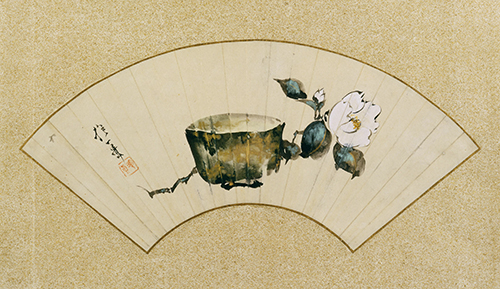Simplicity: Sakai Hōitsu
The first week of August is called National Simplify Your Life Week. What says “simplicity” more than a series of paintings inspired by the Zen Buddhist philosophy of finding Enlightenment in the simplest elements of nature?
 |
| Sakai Hōitsu (1762–1828 Japan), Mallow Blossom, fan representing summer in the Flowers of the Four Seasons series. Ink and color on paper, 6 1/2" x 18 3/16" (16.5 x 46.2 cm). © 2019 Philadelphia Museum of Art. (PMA-730) |
During the 1700s, artists harked back to an earlier Japanese love of color and decorative effects. This style featuring sweeping areas of color contrasting with gold leaf backgrounds is called yamato-e. The painters around Ogata Kōrin (1658–1716) were the true inheritors of the yamato-e tradition in Japanese painting during the Edo period. Yamato-e means Japanese painting, as opposed to Kara-e (Chinese Painting), which were Song-style monochromatic brush landscape paintings. With emphasis on dramatic composition, nature simplified to shapes, and extravagant use of gold leaf, the Kōrin “school” was truly Japanese in outlook.
Sakai Hōitsu is credited with reviving the popularity of the late master Ogata Kōrin. Born into a samurai family, eldest son of the lord of Himeji Castle, Sakai gave up his inheritance to become a painter. Although trained by masters of both the Tosa and Kanō Schools, he was most attracted to works of the Rinpa school (pa meaning school, and rin from [Kō]rin), one of the schools that established the revival of the yamato-e style. Sakai successfully established a Kōrin School in Edo (Tokyo), and published two woodblock albums about Ogata's work, One Hundred Images of Kōrin and Album of Simplified Seals in the Ogata Style, both of which spread Ogata's fame into the 1800s.
Flowers of the four seasons was a time-honored subject in Japanese painting. The depiction of single flowers was an offshoot of the Chinese-inspired bird-and-flower (kachō-ga in Japanese) painting genre that evolved during the Five Dynasty period (907–960 CE) in China.
Sakai produced numerous series on the subject of the four seasons. He translated it admirably into the Rinpa preference for a direct response to nature without concern for academic canon. Typical of the Rinpa painters is the isolation of the subject on a blank background, and the use bright colors and gold leaf (in Camelia and Tea Bowl/Spring) for a richer, decorative surface.
 |
| Sakai Hōitsu, Maple Leaves and Chrysanthemum, fan representing autumn in the Flowers of the Four Seasons series. Ink and color on paper, 6 3/4" x 19 1/8" (17.2 x 48.7 cm). © 2019 Philadelphia Museum of Art. (PMA-731) |
Chrysanthemums are the symbol of Japan and the imperial family. The petals are thought to look like the rays of the rising sun. There are numerous chrysanthemum festivals (kiku matsuri) held in Japan in the autumn.
 |
| Sakai Hōitsu, Ardisia, fan representing winter in the Flowers of the Four Seasons series. Ink and color on paper, 6 1/2" x 18 ¾" (16.7 x 47.7 cm). © 2019 Philadelphia Museum of Art. (PMA-732) |
The red berries of the ardisia are sometimes called “Christmas berries.” Japanese appreciate the winter-growing bush more because of the bright red and green colors contrast with snow.
 |
| Sakai Hōitsu, Camellia and Tea Bowl, fan representing spring in the Flowers of the Four Seasons series. Ink, color, and gold on paper, 7" x 19 1/8" (17.8 x 48.6 cm). © 2019 Philadelphia Museum of Art. (PMA-729) |
The camellia is a harbinger of spring in Japan because it blooms in the late winter. It is also a symbol of perfection and excellence (of insight and meditation). This gives the camellia religious significance in Buddhism. The pairing of a camellia with the tea bowl related to the tea ceremony, a Zen aesthetic, is logical in this composition.
Correlations to Davis Programs: A Community Connection 2E: 7.5; Discovering Art History 4E: 4.4; The Visual Experience 3E: 13.5


Comments